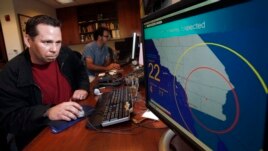22 June, 2017
This is What's Trending Today....
Earthquakes are not uncommon in southern California. Citizens there know how to react and respond if the ground starts shaking.
On Wednesday night, many of them received an email from the U.S. Geological Survey that warned of a large earthquake. The message reported a powerful, 6.8-magnitude quake. Many people also saw similar Twitter messages from the government agency that follows seismic activity around the world.

FILE - In this Sept. 13, 2011 file photo, Anthony Guarino Jr., a seismic analyst at the California Institute of Technology, demonstrates an early earthquake warning system in Pasadena, Calif. (AP Photo/Reed Saxon, File)
So, they expected to feel the earth shake.
But nothing happened.
It turns out Wednesday's message was sent by mistake.
So, how did this happen? Researchers from the California Institute of Technology say they had been using new information to relocate the center of a 1925 earthquake off Santa Barbara, California. That quake severely damaged buildings and killed 13 people.
The new information somehow caused an automated message to be sent out to email accounts and Twitter.
A statement from the USGS said the research "was misinterpreted by software as a current event." It said it is working to fix the issue.
The fake quake report even affected newspaper writers in California and other places. They often use alerts from the USGS to begin their reports. On Wednesday, the Los Angeles Times, for example, sent out a story on the quake that it had to quickly correct.
It later explained on Twitter that the newspaper has a computerized system that produces stories about earthquakes based on the USGS alerts.
But, the Times said, "The USGS alert was incorrect."
The USGS does sometimes release false alarms. But they rarely are for quakes so big or in areas with so many people.
Wednesday's false alarm listed the quake as taking place on June 29 -- the same day as the 1925 event. However, it reported the year as 2025.
Such an early prediction would truly shake up the field of seismology.
And that's What's Trending Today.
I'm Dan Friedell.
The Associated Press reported this story. Ashley Thompson adapted it for VOA Learning English. Mario Ritter was the editor.
__________________________________________________________________
Words in This Story
magnitude –n. a measure of an earthquake's strength or power
seismic –adj. relating to or caused by earthquakes; seismology –n. the study of earthquakes and their processes
automated –adj. made or carried out by a machine rather than a person
misinterpret –v. to not understand correctly
alarm –n. a warning, usually with sound
shake up –v. to make many changes in (something, such as a company or organization)